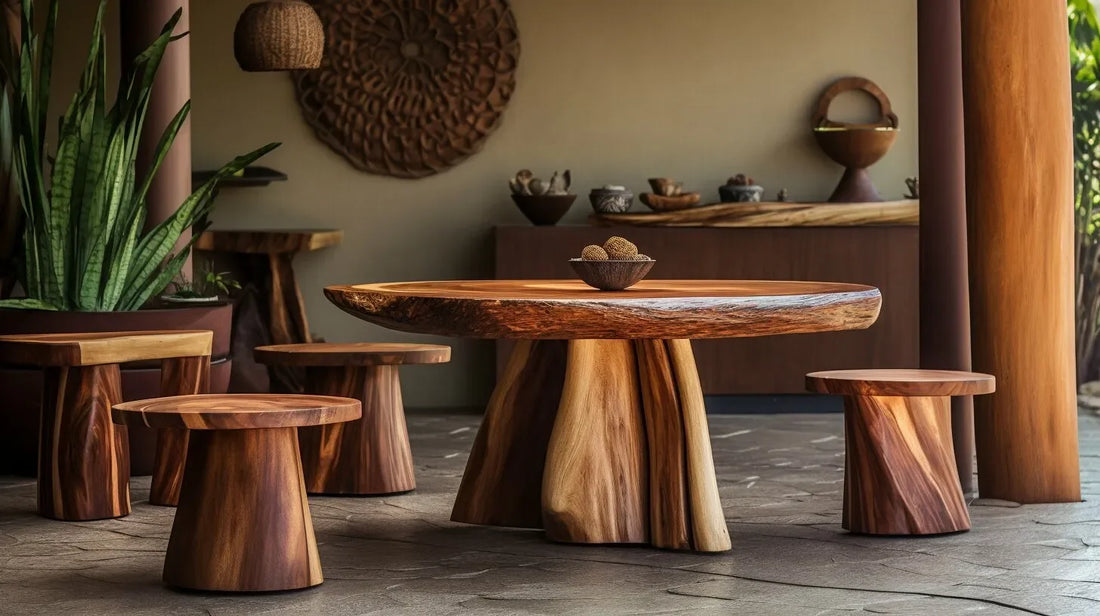Wooden Items
One of the ways to achieve peace in the home environment is by using natural tools and materials. Wood is one of these natural elements that plays a significant role in making household items. Besides its crucial role in providing shelter for early humans, this natural element was also considered the primary material for making household items. Today, alongside other materials, wood continues to play an important role in human life.

The Symphony of Wood
The environment covered with wood absorbs and then reflects emitted sounds softly. This prevents sound entanglement and moderates the difference in wavelength in that area. Dry and light woods like pine create a lot of noise when walking with shoes, while heavy and dense woods like walnut and oak produce a faint and muffled sound. These sounds can be utilized beautifully in various applications and incorporated as a dynamic and variable element in decoration.
Wood has acoustic properties, absorbing sound and reducing sound intensity by absorbing part of the sound energy. Wood-covered environments absorb and diffuse sounds gently. That's why using wood in the home environment reduces sound reverberation.
History of Wood
Through history, wood has been humanity's close companion. From warming our caves to building grand structures, it provided shelter, tools, and even the means to communicate (paper). Egyptians sailed mighty cedar ships, Europeans built with strong oak, and cultures worldwide used woodcarvings to tell stories. Wood's versatility and natural beauty have left an undeniable mark across civilizations.

Employment from Wood
It provides both direct and indirect employment, helping people find work and contribute to the economy. Plus, it focuses on making wood products even more valuable, which is great for our domestic needs and trade.
Wood Preservation
Regular dusting, proper placement, protection from water, pest control, polishing, and oiling.
The Characteristics of Wood as a Construction Material
Physically, wood is durable and strong, yet compared to materials like steel, it is lightweight and flexible. Another interesting feature of wood is that we can often bend a small dead tree branch just using our hands, but it's nearly impossible to pull or even push it. Wood is non-isotropic, meaning a wood mass has different properties in different directions. Traditional wooden buildings are supported by huge vertical poles that transmit forces down into the ground along their length, parallel to the grain. That's a good way to use wood because it generally has high compressive strength when you load it in the same direction as the grain.
The Effect of Wood on Health
Doctor Wallenius, a professor of psychology at the University of Tampere, says that wood has specific psychological effects on people and is effective in reducing stress in people, just like being in nature! Using wood in home decoration and furniture will lead to physical and mental health.

The Economic Impact of Wood
The wood economy, or more broadly, the forest economy (as bamboo is the dominant plant in many countries), is a prominent issue in many developing countries as well as in many other countries with moderate climates or low temperatures. These regions generally have more forests. The use of wood in furniture, buildings, bridges, and as an energy source is well known.

Benefits of Using Wooden Utensils
Wood is one of the most beneficial materials we have at our disposal. It is sturdy yet can be easily cut and shaped into various forms. The majority of wood comes from tree trunks, which is why it's essential to replant trees after cutting them down.
1. Natural Materials
Wood is a natural substance. This means it is biodegradable and renewable. Biodegradable means it can decompose and be recycled. If wood remains for several years, it returns to the soil and adds nutrients to it. Renewability of wood means it can be replaced with further growth. Therefore, as long as trees are replanted after being cut down, wood will be a sustainable material.
2. Antibacterial and Antimicrobial Properties
Wood, coming from nature and not using chemical substances in its construction, possesses antibacterial and antimicrobial properties. Therefore, you can confidently use wooden cutting boards for chopping various fruits and vegetables, as well as wooden spoons for serving food.
It is a misconception that wooden utensils are dirtier or somehow less clean than plastic. In fact, wood harbors fewer bacteria compared to plastic and is naturally antibacterial.
3. Wood makes us feel good
Touching a wooden bowl or cup is a satisfying experience. Research has shown that we have a deep connection with the natural world and respond positively to biophilic design. Using wooden plates, bowls, and utensils can strengthen this connection with nature in our daily lives. As a result, we will enhance our sense of well-being.
Biophilic design is a concept used within the building industry to increase occupant connectivity to the natural environment through the use of direct nature, indirect nature, and space and place conditions.

4. Durability and Longevity of Wood
Another characteristic of wood is its durability. Quality wooden utensils are durable and will have a long lifespan. If cared for properly, wooden utensils will maintain their appearance year after year. Breakage and scratches in these utensils are rare occurrences.
A clear advantage of wood over ceramic is its durability. Ceramic is likely to chip or break into smaller pieces if dropped.
5. Wooden Utensils Are Healthier
The increasing negative impact of plastic on human health is concerning. At every stage of life, plastic is detrimental to our health. When using plastic utensils, there are risks of ingestion or inhalation of micro plastic particles and hundreds of toxic substances. This issue contributes to the development of cardiovascular diseases, cancer, and immune disorders. In contrast, wood poses no harm and serves as a calming material for mental health
6. Cooking with Wooden utensils won’t leach harmful chemicals
Wood is safer. Wood is non reactive and will not leach harmful chemicals into your food. Wooden utensils, unlike plastic and metal ones, do not react to acids present in foods and do not transfer toxic substances to the food. Therefore, they contribute to the slower spoilage of food.

7. No Difference in Food Taste
Using wooden cooking utensils can help maintain the flavor and taste of the food. As mentioned in the above paragraphs, food remains healthy in wooden utensils, and this feature ensures that there is no difference in the quality and taste of the food.
8. Eating Peacefully
The texture and quality of wood are such that eating in it is calm and without creating noise. This makes for a better dining experience.
The use of metal utensils such as spoons, bowls, and spatulas in kitchens creates noise, but using wooden utensils like wooden bowls and spoons solves this problem. Another benefit of wooden spoons in kitchens is the absence of noise.
9. Heat Resistance
Wooden utensils prevent burns because wood is a heat insulator, making it ideal for safe cooking. For instance, using a wooden spoon in a hot pot for an extended period won't heat up the handle and burn your hand.
10. Wooden utensils do not scratch your cookware.
Wooden spoons have the highest usage among other wooden utensils. One of the benefits of using wooden spoons is that they have a soft and gentle texture, so they do not scratch other utensils like Teflon ones.
11. Unique Design and Beauty of Wooden Utensils
Wooden utensils bring a timeless elegance to your kitchen that is difficult to match. The natural beauty of wood, with its unique grain patterns and warm tones adds a touch of sophistication to your kitchen.




